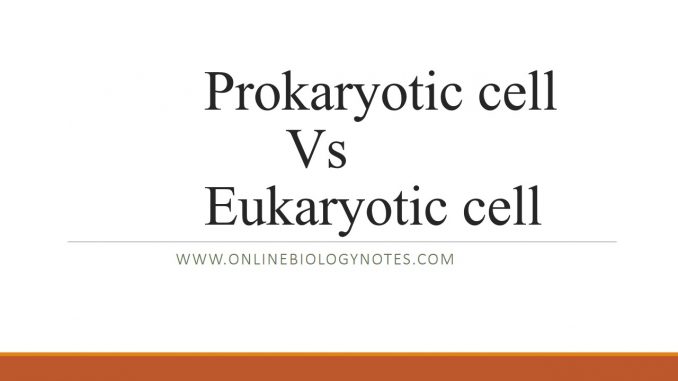
There are two fundamentally different types of cells; the prokaryotic cells and eukaryotic cells. In prokaryotic cells, the nuclear material (DNA) lies freely in the cytoplasm in the region known as Nucleoid. They do not have true nucleus. In eukaryotic cells, the nuclear material (DNA) is found inside a nucleus, which is surrounded by double membraneous layer called nuclear membrane. In eukaryotes, the DNA is associated with proteins to form chromosomes.
Other major differences between Prokaryotic cells and eukaryotic cells are as follows,
| Features | Prokaryotic cells | Eukaryotic cells |
| Cell size | Average diameter 0.5-10µm | 10-100µm in diameter; usually 1000-10,000 times the volume of prokaryotic cells |
| Form | Mainly Unicellular | Mainly multicellular, (except Protista, many of which are unicellular) |
| Evolutionary origin | 3.5 thousand million years ago | 1.2 thousand million years ago and these cells evolved from prokaryotic cells |
| Cell Division | Mainly by binary fission with spindle fiber formation | By mitosis, meiosis or both and form spindle fiber |
| Genetic materials | DNA is circular and lies freely in cytoplasm | DNA is linear and contained in nucleus |
| Nucleus | Incipient nucleus (No true nucleus) | True or real nucleus |
| DNA | DNA is naked (Not associated with proteins or RNA to form chromosome) | DNA is associated with proteins and RNA to form chromosome |
| Nuclear membrane | Absent | Present |
| Nucleoplasm | Absent | Present (Well organized) |
| Cell wall | Rigid and made up of peptidoglycan or murein (Murein or peptidoglycan is composed of polysaccharides associated with amino acids) | Cell wall of plants and Fungi are rigid and composed of cellulose in plant, chitin in fungi Cell wall is absent in animal cell |
| Flagella | Simple type, lacks microtubules and lack 9+2 arrangement, extracellular, 20nm in diameter | Complex type, with 9+2 arrangement of microtubules, intracellular, 200nm in diameter |
| Cell organelles | Very few or absent None are surrounded by double membrane | Many organelles Double membrane bound cell organelles such as Mitochondria, ER, chloroplast, Golgi complex, lysosome, vacuoles, etc are present |
| Ribosome | 70s type | Both 70S and 80S type |
| Endoplasmic reticulum | No endoplasmic reticulum is present | Endoplasmic reticulum are of two types; Rough and smooth type Ribosomes may be attached to endoplasmic reticulum |
| Respiration site | Mesosome in bacteria except cytoplasmic membrane in Blue green bacteria | Mitochondria for aerobic respiration |
| Photosynthesis | Bacteriochlorophyll in bacteria | Chloroplast (Plastid) contains chlorophyll which are stacked into lamellae or grana |
| Nitrogen fixation | Some bacteria have ability to fix atmospheric Nitrogen | None have the ability to fix Nitrogen |
| Centrioles | Absent | Present in Animal cells |
| Cyclosis (movement of cytoplasm) | Absent | Present |
| Exocytosis and Endocytosis | Absent | Present |
| Absent9+2 arrangement of microtubules in flagella | Present | |
| Duration of cell cycle | Short | Long |
| Examples | Bacteria, Blue green Bacteria | Plant, Animal, Fungi |
